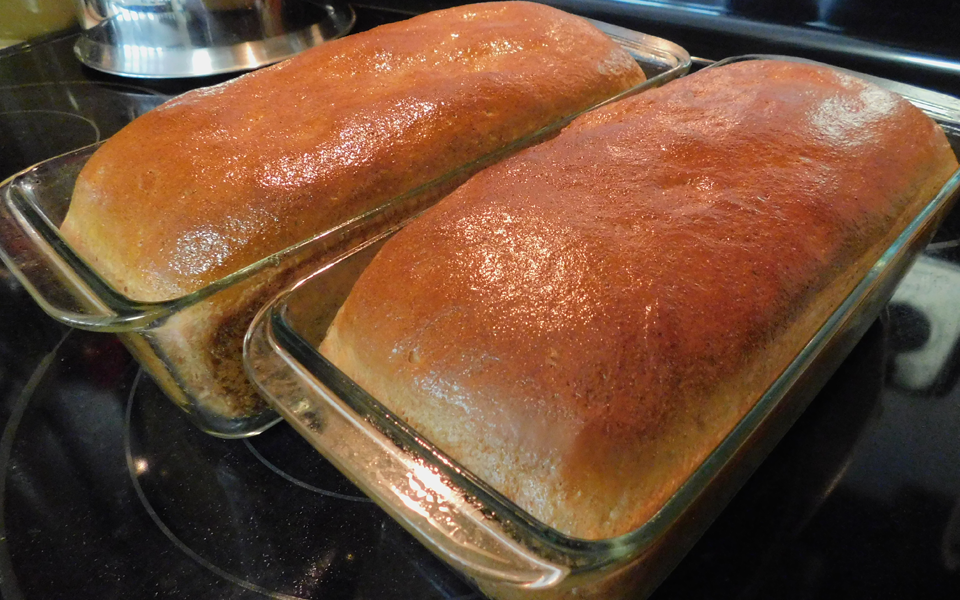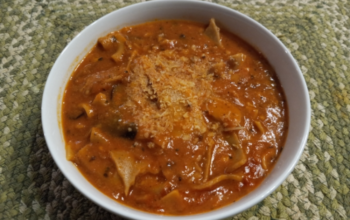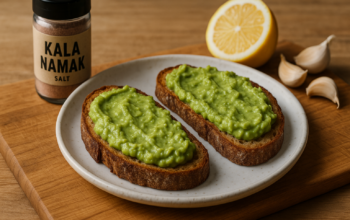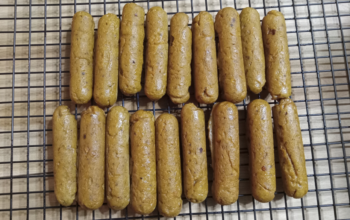Agave-Spelt Bread
I grew up on homemade bread. We ate bread every single day. I remember folks coming by the house to buy my mom’s bread. I often kick myself for not paying closer attention. That recipe is gone forever. However, I have a favorite of my own, which I changed from a honey-wheat version. It’s a mix of organic spelt and white whole wheat flour (which is 100% whole wheat flour, for those who don’t know), but I called it agave-spelt because I once used more spelt flour than whole wheat flour. Now, I just think that the spelt helps to lower the wheat’s acidity; and therefore, I think the spelt has earned the right to be used in the title.
First a note on the flour and then I’ll get into the agave. Spelt is an ancient grain, very similar to whole wheat flour, but has less gluten. In the book, Ministry of Healing on p. 300.3, we understand that we must use wholesome flour: “For use in breadmaking, the superfine white flour is not the best. Its use is neither healthful nor economical. Fine-flour bread is lacking in nutritive elements to be found in bread made from the whole wheat. It is a frequent cause of constipation and other unhealthful conditions.” I am unable to stomach 100% whole wheat flour by itself. I am yet looking into it, but I have recently found that orange juice helps somehow. Whole wheat flour has more gluten in it than spelt. So, I mix the two, but I still add gluten. This has been good for me. I can even make the bread with 100% spelt flour, but I’ll have to add gluten to the mix to soften it. Bread flour typically has more gluten in it than regular flour.
So, you ask, “What exactly is spelt and what is its origins?” A 1996 study on “Alternative Wheat Cereals as Food Grains,” stated that “Some of the earliest recordings of spelt appear in the Bible (Exodus 9:30, Isaiah 28:25, and Ezekiel 4:9).” This nutty-flavored, biblical grain, also known by its scientific name, Triticum speltum, is often treated by experts as the grandfather of wheat. Spelt nutritional value and flavor is the result of the tough hull on each kernel, which keeps the kernel protected before processing. This positively enhances nutrients in spelt, keeping it from harmful crop insects and contaminants. Due to its composition, spelt is easily soluble in water, which lends to its easy digestive benefits. Spelt can be found among the low alkalinizing foods, which may make suitable for people with some gluten allergies. Though it is low in acid, it still contains gluten, which makes it unsuitable for anyone with Celiac disease, who need other grain/wheat alternatives. There’s also an array of health benefits (See article on ” What Are the Benefits of Eating Spelt Flour?”).
Nutritionally, spelt is high in carbohydrates, fiber, and protein. In a 2000 study, the researchers found that when bread is made from whole spelt wheat flour its starch content is reduced overall and it has more resistant starch. It also contains an array of nutrients, such as iron, copper, manganese, magnesium, phosphorous, potassium, zinc, selenium, niacin, thiamin, vitamin B6, and folic acid. An Organic Facts article on “Health Benefits of Spelt” revealed that spelt contains health benefits that aids in increasing circulation, lowering cholesterol levels, regulating metabolism, building resilient bones, improving immune system, decreasing blood sugar, and in boosting digestion. According to this site, this healthful grain is often preferred in making bread crusts and flatbread pizzas because it retains a hard shell that is not tough nor hard to chew.
Now, the agave (and for me, it must be organic raw agave) is a bit tricky. If you do your research, not all agave nectar is created the same. You might as well be using high-fructose corn syrup if you purchase some agave products. The slowly metabolized agave, which has the low glycemic index, is the raw agave nectar. Usually folks like the light agave, which has often been heated to remove the strong agave flavor from the syrup and thereby also removing the nutritional value (See article on Agave from Organic Facts for nutritional composition). However, the darker agave is often called “raw” agave, which means it hasn’t been heated to the extent of removing the nutritional content. I only buy the dark, organic, raw kind. Be sure to store it in a dry, cool, and dark place. I believe the general rule for healthy sweeteners is that they must have nutritional value and not be refined. Oh yeah, not that we’re talking about sugar here, but all white refined sugar is cut with bone char, making it not a product for plant-based consumption. If it says organic, that’s the only way you can deem it safe (See article “Is Your Sugar Vegan?”). Well, now you know!
I used to only buy my baking yeast in bulk. I’d store this surrounded by plastic in an air tight container in the freezer. It keeps about a year; but some say six months. It kept for a year for me. This is good when you make bread often. Before, I was paying about $7-$8 dollars a month for yeast, but buying yeast in bulk had me paying only $9 a year. My budget was happy. Now, the yeast is not labeled organic, but I don’t think it matters because yeast is a fungi (See Red Star’s resource collection on the Science of Yeast). As I said in a previous blog post, I have made a choice not to include fungi in my recipes, but now I will have to re-think that! I have read nowhere that baking with yeast (leaven) is prohibited. Perhaps I’ll write more on this later because yeast also ferments the sugars in the dough to get it to rise. I know of health reformers who believe we should eat nothing fermented. As I am researching various foods, I am running into things that make me search for more answers in the Bible and the Spirit of Prophecy. We’ll take this journey together. As I find out things, so will you!
Now, typically, once the bread is baked, it is most healthful two to three days later (See Counsels on Diets and Foods, pp. 317.2; 319.1) to make sure all of the alcohol from the yeast has dissipated. I do believe that we must truly consider this paragraph closely in the book, The Ministry of Healing, p. 301.2: “Bread should be light and sweet. Not the least taint of sourness should be tolerated. The loaves should be small and so thoroughly baked that, so far as possible, the yeast germs shall be destroyed. When hot or new, raised bread of any kind is difficult of digestion. It should never appear on the table. This rule does not, however, apply to unleavened bread (my next experiments). Fresh rolls made of wheaten meal without yeast or leaven, and baked in a well-heated oven, are both wholesome and palatable.” So many like hot bread, but it is very injurious to the system unless free from yeast. Stay tuned, those of you who like hot bread! *smile*
This is the basic recipe, but you may add any other ingredients as you see fit. Make it your own! I truly love this recipe and so does my family. This goes well with the plant-based butter and I often make croutons with this bread once it starts drying out (Recipe coming soon!). If you have a large family, this bread should not stick around. If your family is small and you make two small loaves, freeze one. I pray you like it.
I know I gave you many things to think about in this post. I pray you take one section at a time and contemplate and research these things for yourself! Now, without any further ado, here is the recipe!
Agave-Spelt Bread
Ingredients
- 1 ¼ cup warm water around 80 degrees
- ¼ organic orange juice (takes away that whole wheat flavor…yay!!!)
- ½ cup organic raw agave nectar
- 2 tablespoons of avocado oil (or any non-hydrogenated oil of your choice)
- 4 cups flour (I use 1 cup of organic spelt flour sifted with 3 cups of organic 100% white whole wheat flour)
- ¼ cup vital wheat gluten flour (This adds the gluten needed for the bread rising. If using bread flour instead of whole wheat, omit this ingredient and add ¼ cup of spelt instead.)
- 2 teaspoons sea salt or Himalayan pink
- 2 teaspoons active yeast (This is a measurement for loose yeast. I also use instant yeast or rapid rise and if using a packet of yeast, I put the whole pack.)
- Oil spray to coat bread pan(s), I use cold-pressed avocado oil
Instructions – BY HAND:
- Preheat the oven to 350 °F. Measure out all ingredients but the oil. In a large bowl, start the process by mixing the warm water (about 80 degrees) with one tablespoon of the agave nectar and the yeast. Let sit for about 10 minutes. until yeast proofs.
- Once the yeast proofs, add the rest of the agave nectar, 1.5 tablespoons of the oil, and salt to this and stir.
- Mix all flours and gluten together. From that mixture, stir in two cups of flour mixture, just until the mixture thickens, but is not dough or runny. Once the flour is mixed, put in a warm place* for thirty minutes until it rises and is spongy and sticky.
- Once 30 minutes has passed, add one (1) more cup of flour and stir until you cannot stir it any more (or add more until you cannot stir any longer).
- Put a bit of the remaining flour on the counter. Set the timer to 8-10 minutes and be sure to knead the dough for at least that long. Pour out mixture onto the counter and knead while adding more and more flour as needed.
- Once the dough is well-kneaded (and a bit sticky), then put the 1/2 tablespoon of oil in a large bowl and coat the dough with the oil. Put the the bowl in a warm place* (see tip below) and let the dough rise another 50 minutes or until the dough doubles in size.
- Punch down the dough aggressively and form into one big loaf, or cut into two smaller loaves. Spray the bread pan(s) with oil spray and place the dough inside loaf pan(s). Put pan(s) into warm place* and let rise for about 30-50 minutes or until the dough is about an inch or more above the rim.
- Bake at 350 degrees for 30-35 minutes, depending upon size of loaf. (I use glass bread pans and so I’m able to check the sides of the pan to see if my bread is truly done. If it’s not done, which means the sides are too light or looks like they are doughy or soggy, I’ll add 2 extra minutes and check again.)
- Once done, take it out of oven, coat the top lightly with oil or agave water to shine, and let sit in the pan for an additional 10 minutes, then remove from pans and place on the cooling rack for about 1-2 hours before bagging.
- Eat it two to three days later!
——————————–
*TIP: To get that warm place, I heat the oven to 175 and then TURN IT OFF. I take a small saute stainless steel pan and boil a bit of water in it and place on the bottom rack of the stove. This creates a warm moist environment for the bread to optimally rise. Put bread UNCOVERED on top rack in the oven. I never cover it since it’s in an enclosed space. However, if you are NOT going to use your oven as the warm place, then you need to cover it with cellophane wrap or a damp towel (if you use a cloth towel, your bread may stick to the towel if the towel is not wet) and double the minutes it takes for it to rise (about an hour to an hour and a half). I find the oven the best way for the bread to rise.
**RECIPE UPDATED: For this recipe, whole wheat flour is preferable to unbleached bread flour because the the germ and wheat fiber (bran) is not removed. However, I have mainly made this recipe with a mixture of unbleached bread flour and spelt. I am transitioning to 100% whole wheat flour presently. I have learned that I had to up the vital wheat gluten when not using bread flour. I also added organic orange juice to lessen the whole wheat flavor that I cannot stomach.
—
Instructions — BY BREAD MACHINE:
This recipe also works well in a bread machine. I know that many of you are probably going to make this in a bread machine; so if you are using a machine, follow these instructions: In the order shown, add ingredients. Select your desired crust or select the dough cycle. (Wet ingredients must be added first as displayed by the ingredients list!). If using the dough cycle, once the cycle is completed, form the dough into a loaf (or small loaves) and let the dough rise once more in the pan. Bake using the instructions above in the BY HAND section.
—
DOUBLE THE RECIPE: You may also double the recipe BY HAND to make three medium-large loaves of bread, but DO NOT TRY THIS IN THE BREAD MACHINE! Only do this if you are making bread by hand. If this is the first time, please stick to this recipe until you feel you can double the recipe successfully!
ECONOMICAL TIP: Now, for this recipe, I use a mixture of organic white whole wheat flour and spelt. If you do not buy both flours in bulk, you’ll be spending an arm and a leg in order to purchase them. If you co-op, great! I don’t have that luxury right now; so I try to buy in bulk and freeze. Interestingly, I once saw Whole Foods filling an organic oat canister from the bulk bag of the same company I buy my organic spelt flour, Great River Organic Milling. Now, a 25 lb bag of organic spelt flour will cost almost $40 on Amazon, but may be more expensive on other sites. If you are like me and buy multiple things bulk to save money, then you may want to make sure you have somewhere dry, dark, and cool to store these things in order to preserve them, like an armoirie. So, if you do not have a place to store these things, perhaps buying in bulk is not for you. Currently, I also buy my raw agave online. This and the flour are the most expensive of the things I buy. Now, with all that said, if you cannot afford the spelt or the agave, then this same recipe will work with all whole wheat flour in the place of spelt and honey. In truth, I also use honey for this same recipe. It’s very practical to use what’s in your cupboard and in your budget with prayer. If my budget is tight and I can’t always buy organic. I buy the healthiest I can afford. Don’t let the cost stress you out. If I can’t always buy organic apples, I still eat apples. I try not to buy the GMO kind though. So, do what is within your budget with prayer. God will bless.





